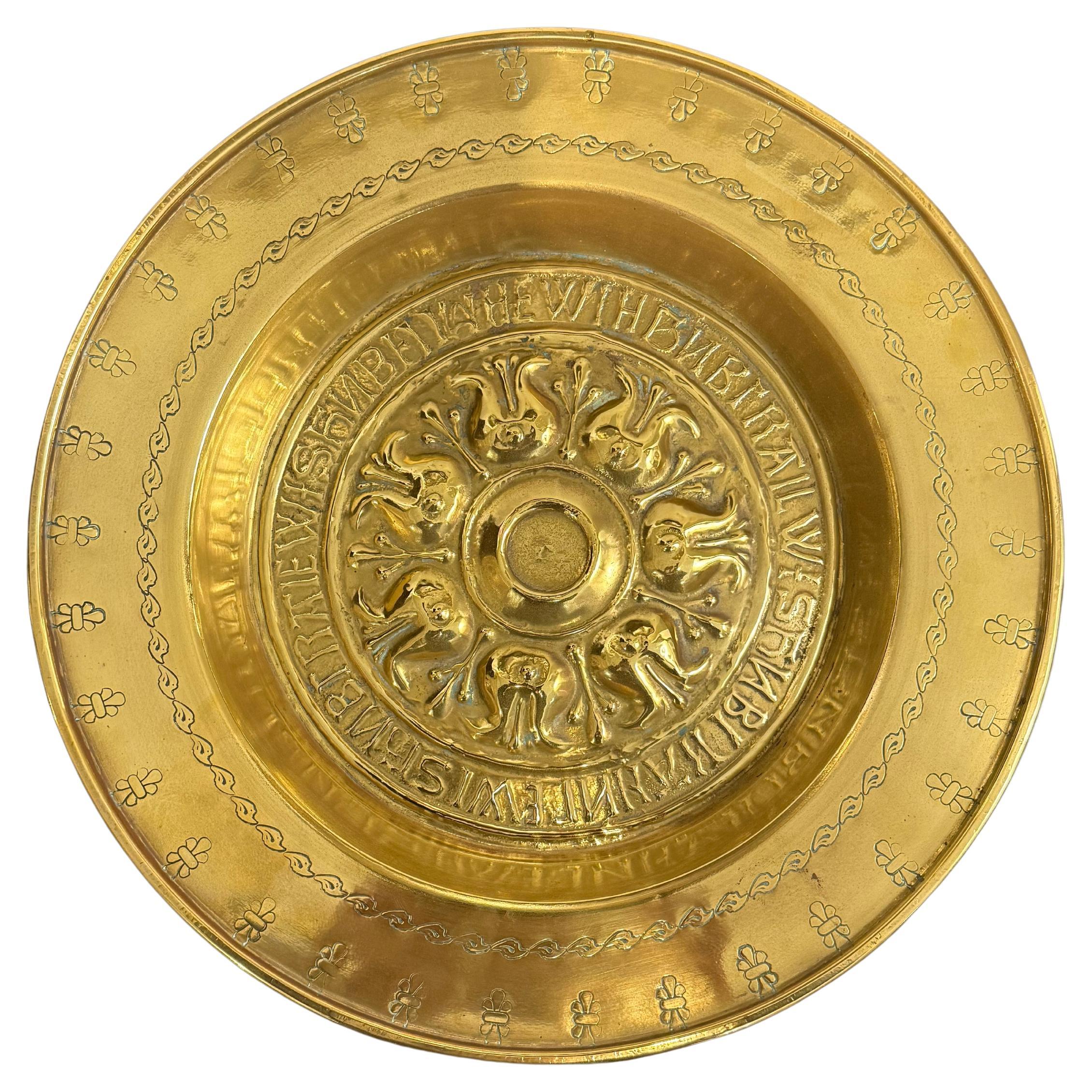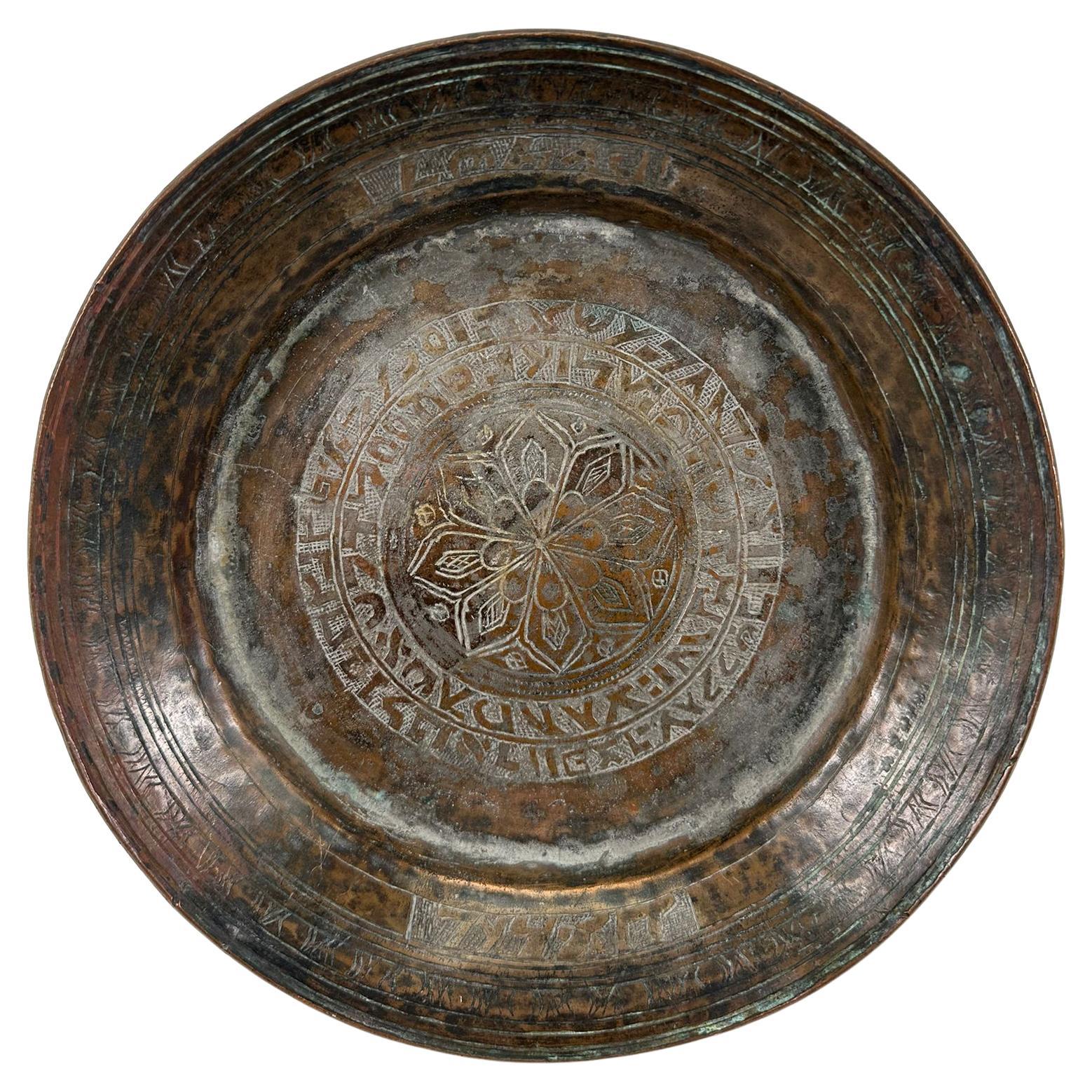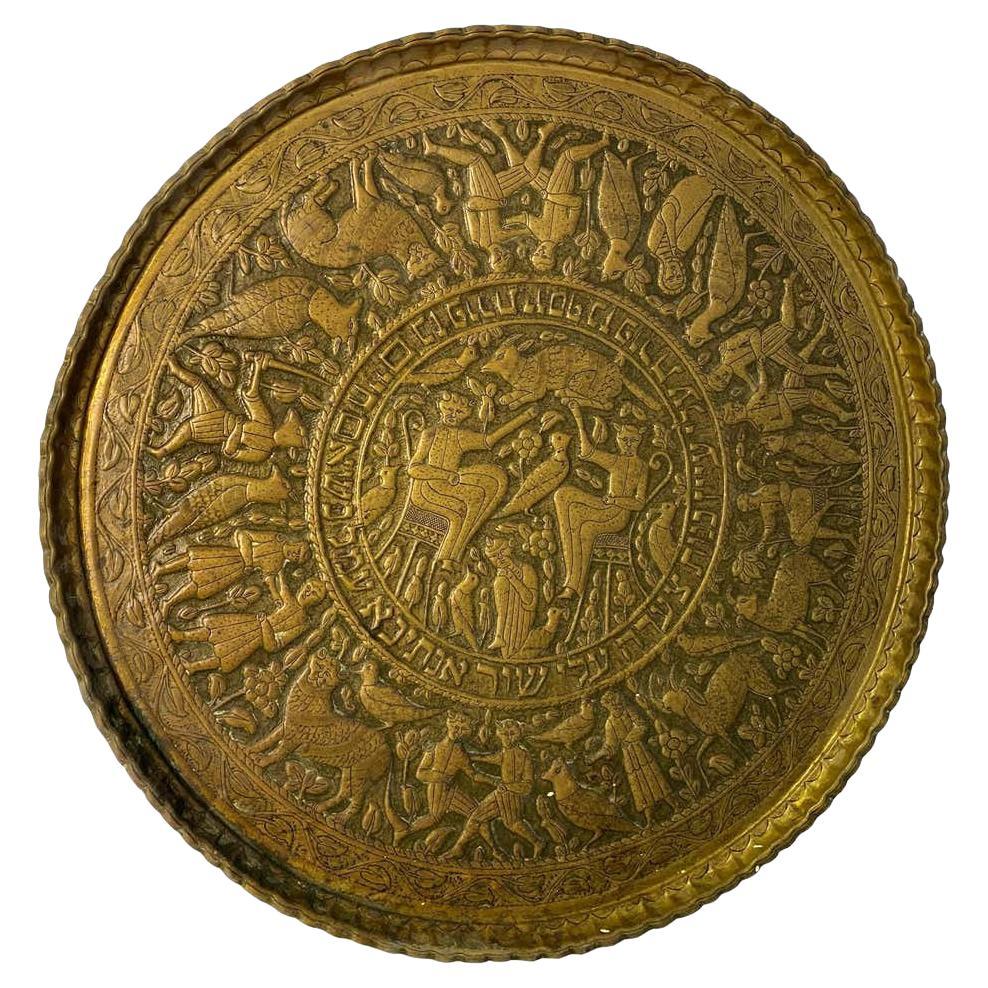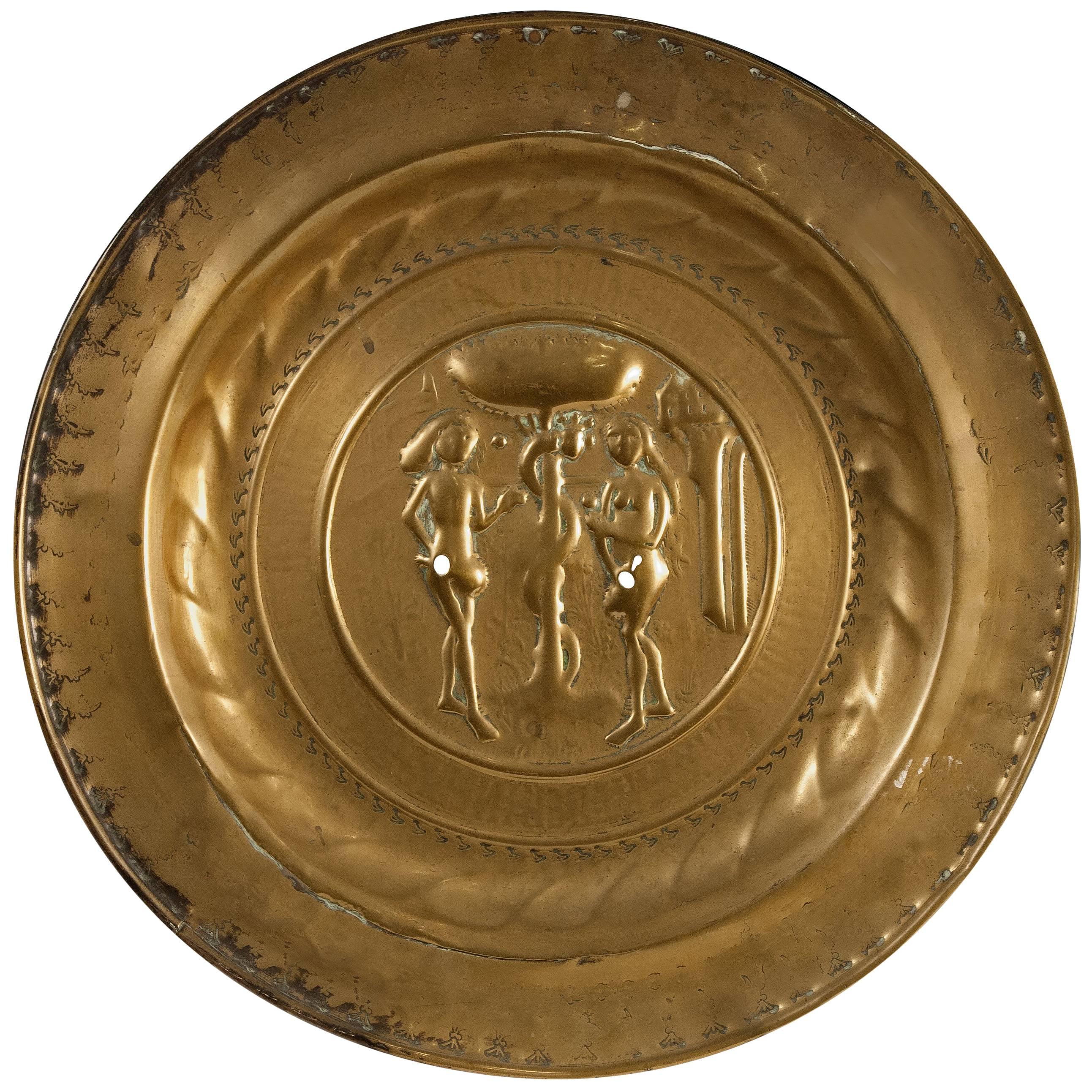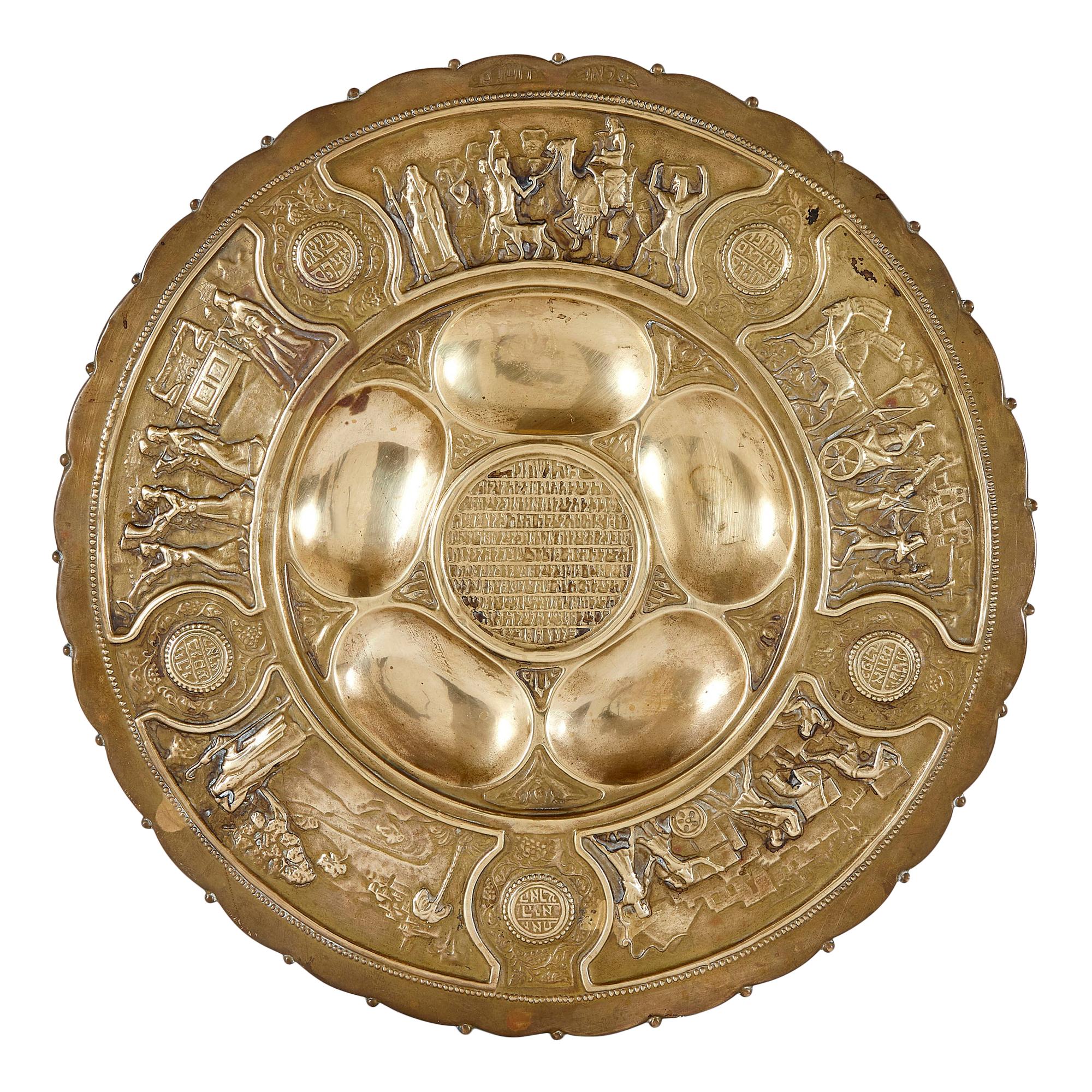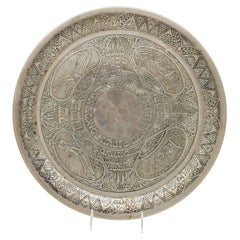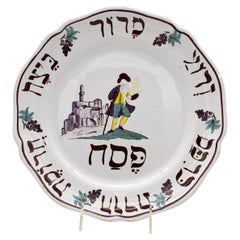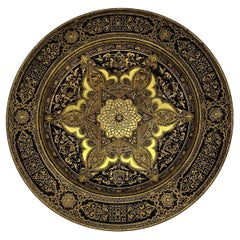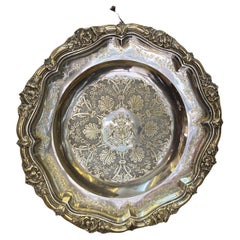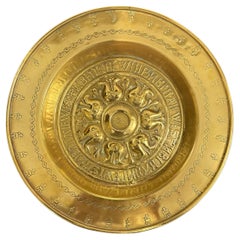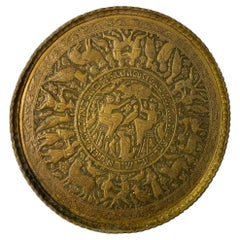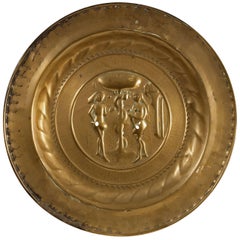Items Similar to Rare early Bezalel Jerusalem JUDAICA etched brass garden of eden plate
Want more images or videos?
Request additional images or videos from the seller
1 of 13
Rare early Bezalel Jerusalem JUDAICA etched brass garden of eden plate
$4,200
£3,186.86
€3,643.89
CA$5,866.26
A$6,522.48
CHF 3,405.68
MX$79,394.52
NOK 43,455.01
SEK 40,715.27
DKK 27,195.05
Shipping
Retrieving quote...The 1stDibs Promise:
Authenticity Guarantee,
Money-Back Guarantee,
24-Hour Cancellation
About the Item
very rare Bezalel Jerusalem plate , this amazing plate has the best subject And artistic Design i have seen in a lot of years, the plate has 5 different scenes from the story Of Adam And Eve in the garden pf Eden.
On the middle of the plate the is an Hebrew inscription, it is parts from the 5 lines that describe The 5 scene on the plate:
"וַיִּ֩יצֶר֩ אֶת־הָֽאָדָ֗ם עָפָר֙ מִן־הָ֣אֲדָמָ֔ה"
"And the Lord God formed man of dust from the ground"
"לֹא־ט֛וֹב הֱי֥וֹת הָֽאָדָ֖ם לְבַדּ֑וֹ"
"And the Lord God said, "It is not good that man is alone"
"'וַיִּֽהְי֤וּ שְׁנֵיהֶם֙ עֲרוּמִּ֔ים"
"Now they were both naked"
"וַתִּקַּ֥ח מִפִּרְי֖וֹ וַתֹּאכַ֑ל וַתִּתֵּ֧ן גַּם־לְאִישָׁ֛הּ"
"She took of its fruit, and she ate, and she gave also to her husband"
"וַיְגָ֖רֶשׁ אֶת־הָֽאָדָ֑ם וַיַּשְׁכֵּן֩ מִקֶּ֨דֶם לְגַן־עֵ֜דֶן אֶת־הַכְּרֻבִ֗ים וְאֵ֨ת לַ֤הַט הַחֶ֨רֶב֙ הַמִּתְהַפֶּ֔כֶת לִשְׁמֹ֕ר אֶת־דֶּ֖רֶךְ עֵ֥ץ הַֽחַיִּֽים:"
"And He drove the man out, and He stationed from the east of the Garden of Eden the cherubim and the blade of the revolving sword, to guard the way to the Tree of Life."
This rare plate is fully marked on the back "BEZALEL JERUSALEM" in Hebrew, the Jerusalem Mark is a bit worn but it is present, on the top of the mark there is the number 522 which is Probably the model number, this plate was mad on the early 1910s or even earlier and it is one of Bezalel earliest works, it is not known who is the artist but the artistic style is typical of Reuben Leaf Lipschitz, he was working in Bezalel in 1912-1916 and was the manager of the etching Department in this time frame, in 1916 he moved to the USA to escape joining the ottoman army in ww1. he stayed in the USA and became a graphic designer who designed and decorated Synagogues he also made graphic designs a illustrations to Hebrew books.
Most have in any important Judaica or Bezalel collection
- Dimensions:Height: 1 in (2.54 cm)Diameter: 7.3 in (18.55 cm)
- Style:Arts and Crafts (Of the Period)
- Materials and Techniques:
- Place of Origin:
- Period:1910-1919
- Date of Manufacture:1913
- Condition:Wear consistent with age and use. Condition of the plate is very good, there are some scratches and some normal wear, the hanger On the back is missing as you can see in the pictures but otherwise good original condition to an Item is 100+ years.
- Seller Location:Tel Aviv - Jaffa, IL
- Reference Number:1stDibs: LU8130238132062
About the Seller
No Reviews Yet
Vetted Professional Seller
Every seller passes strict standards for authenticity and reliability
1stDibs seller since 2023
- ShippingRetrieving quote...Shipping from: Tel Aviv - Jaffa, Israel
- Return Policy
Authenticity Guarantee
In the unlikely event there’s an issue with an item’s authenticity, contact us within 1 year for a full refund. DetailsMoney-Back Guarantee
If your item is not as described, is damaged in transit, or does not arrive, contact us within 7 days for a full refund. Details24-Hour Cancellation
You have a 24-hour grace period in which to reconsider your purchase, with no questions asked.Vetted Professional Sellers
Our world-class sellers must adhere to strict standards for service and quality, maintaining the integrity of our listings.Price-Match Guarantee
If you find that a seller listed the same item for a lower price elsewhere, we’ll match it.Trusted Global Delivery
Our best-in-class carrier network provides specialized shipping options worldwide, including custom delivery.More From This Seller
View AllDecorative Judaica Passover plate by Heinrich Schwed. Munich, 1924.
Located in Tel Aviv - Jaffa, IL
Decorative Passover plate by Heinrich Schwed. Munich, 1924.
ALPACA, etched.
This Large plate, featuring a round medallion in the center, with a Matzah which in this plate is hand c...
Category
Vintage 1920s Platters and Serveware
Materials
Alpaca
French faience Passover plate, JUDAICA 19th century
Located in Tel Aviv - Jaffa, IL
this plate has a creme white background, the center painted with a man holding a lamb before a cityscape, probably a depiction of Jerusalem by someone who never actually visited the city or even see it, under the man there is the word Passover "פסח" the rim with the order of the Seder, and some grape vines between them.
Passover, also called Pesach ( Biblical Hebrew: חַג הַפֶּסַח, romanized: Ḥag haPesaḥ), is a major Jewish holiday, one of the three pilgrimage festivals, that celebrates the Biblical story of the Israelites' escape from slavery in Egypt.
Pesach starts on the 15th day of the Hebrew month of Nisan which is considered the first month of the Hebrew year. The Hebrew calendar...
Category
Antique Late 19th Century French Victorian Platters and Serveware
Materials
Pottery
Spanish Toledo Gold Inlaid Damascene Iron plate, islamic art, Felipa Madrid 1894
Located in Tel Aviv - Jaffa, IL
This is a rare chance to own a piece of important "ZULOAGA WARE" (The preservation of damascening in Spain was almost entirely due to the genius of a single family, the Zuloagas ) or "Toledo gold...
Category
Antique 1890s Spanish Islamic Platters and Serveware
Materials
Gold, Iron
$22,000
Free Shipping
Important Rothschild family French silver presentation plate by Maurice Mayer
Located in Tel Aviv - Jaffa, IL
extremely rare french silver presentation plate/ dinner plate.
this important plate is one of the best quality work and engraving i have ever seen in my life, the outer rim is all adorned
and ornate with flowers in neoclassical style, and the actual plate is all hand engraved with the most incredible engraving with gold plating on just the engraved patterns what makes the plate looks like the gold plated part is 3 dimensional.
This important plate was made in paris by the famous silver master Maurice Mayer...
Category
Antique Late 19th Century French Neoclassical Sterling Silver
Materials
Gold Plate, Silver
Rare "Safed" kiddush cup, late 19th century Poland/ Eretz ISRAEL
Located in Tel Aviv - Jaffa, IL
This 84 silver cup was made in Europe, in Poland or parts of Poland that are in modern Russia in the 19th century, the interesting and important in this cup types is that they were s...
Category
Antique 1890s Israeli Sterling Silver
Materials
Silver
extremely rare Algerian Judaica silver, jewish Dowry box early 19th century
Located in Tel Aviv - Jaffa, IL
Amazing and scarce JUDAICA object, we have here one of the most touching jewish objects we had for a long time, this small silver dowry box was made in Algeria in the early 19th century, it is all covered with symbols of jewish faith and of couples, the sliding lid has 2 flanking birds with hamsa (protective hand) on each side and a flower vase in the middle.
one side shows two flanking lions with a tree in the middle and the other side shows again two big and two small birds with a flower bowl in the middle, front side has a key hole and next to it there is the Hebrew inscription ס״ט״" which says Siman tov or in English "a good sign" it is taken from the wedding blessing, underneath the lock there is another inscription with the name ״עזיזה בת אברהם בן חמו״ which is the name of the bride, her father and her grandfathers name.
the box is full marked a lot of times with the silversmith mark, every side of the box is marked.
this box was probably ordered by the grooms family to hold the jewelry they are giving to the bride as dowry, this type of objects are rare and there are just a few of them on museum collections.
DOWRY (Heb. נְדֻנְיָה), the property a wife brings to her husband at marriage; the Yiddish equivalent, nadn, is from the same root. The custom of nedunyah became clearly defined and institutionalized only in the talmudic period. In biblical times, mohar (מֹהַר), whereby the groom bought his wife from her father (Gen. 24:53; Ex. 22:15–16; Hos. 3:2), was the accepted practice. It was then customary that the groom give the bride gifts, and that she bring certain property to her husband's home upon marriage: slaves, cattle, real estate, etc. (cf. Gen. 24:59–61; 29; Judg. 1:14ff.; I Kings 9:16). Evidence of the custom of nedunyah is to be found in Tobit (7:14; 8:21) and in the Assuan papyri (Cowley, Aramaic, nos. 15, 18). Gradually, mohar was superseded by the ketubbah custom according to which the husband merely assumed the responsibility of compensation to his wife in case he divorced her: he had to pay her 200 zuzim if she had been a virgin at the time of marriage, and 100 zuzim if a widow or divorcée (see *Ketubbah).
By talmudic times, the institution of nedunyah was prevalent; the father gave a dowry to the bride since the daughter was excluded from paternal inheritance. Fifty zuzim (equivalent to the worth of 180 grams of silver) was the minimum amount a father was obliged to give to his daughter (Ket. 6:5). Parents usually gave much more, according to their social standing. Community funds provided the dowry for an orphan or a very poor girl (ibid.; cf. Sh. Ar., YD 251:8). In case of her father's death, the brothers of a minor girl were obliged to give her the minimum dowry, and the court estimated how much her father would have given her above the minimum dowry. The sum was then taken out of the father's estate and given to the daughter upon majority (Ket. 6:6; 68a–69b). In the absence of such an estimate, each daughter was entitled to receive one-tenth of the value of her father's estate in money, or in valuables (Yad, Ishut, 20:4–7; Sh. Ar., EH 113:4). If the father was unable or unwilling to pay the promised dowry at the betrothal ceremony, the groom could refuse to marry his bride (Ket. 13:5; Ket. 108b–109a). Insistence on exact payment of the promised dowry, however, was frowned upon by later rabbinic authorities (Rema to Sh. Ar., EH 2:1). In certain communities it was customary for the groom's father to make a dowry contribution equal to that of the bride's father (Ket. 102b). The dowry, whether given in real estate, slaves, money, or chattel was recorded in the marriage contract (the ketubbah) and in some instances one-third or one-fifth of the actual value of the dowry was added to the sum mentioned in the ketubbah. Based upon a decree enacted by *Simeon b. Shetah (first century C.E.), the Talmud ruled that the husband and his entire property were liable for compensation as stipulated in the ketubbah, either in case he died (when she collected the sum specified in the ketubbah from the heirs) or in case he divorced his wife (Ket. 82b). For the status of the dowry and the husband's rights and obligations, see below. The rabbinic enactments (Takkanot Shum) by R. Jacob *Tam and by the rabbinic synod of the communities of Speyer, Worms, and Mainz (Germany) stipulated that if a woman died...
Category
Antique Mid-19th Century Algerian Tribal Art
Materials
Silver
You May Also Like
A German Repousse Brass Alms Dish, 17th Century
Located in ARMADALE, VIC
A German Repousse Brass Alms Dish, 17th Century
Origin and Function:
These brass dishes were primarily made in Nuremberg, Germany, and were initially secular flatware used by the we...
Category
Antique 17th Century German Decorative Dishes and Vide-Poche
Materials
Brass
Mid-19th Century Syrian Kabbalistic Copper Plate – Handcrafted and Engraved
Located in New York, NY
This intricately engraved copper plate from mid-19th century Syria is a remarkable example of Kabbalistic artistry and spiritual symbolism. Featuring finely inscribed Hebrew letters,...
Category
Antique Mid-19th Century Syrian Religious Items
Materials
Copper
Israeli Circular Brass Plate, 19th Century, Inscribed in Hebrew
Located in Southall, GB
Israeli circular brass plate, 19th century, inscribed in Hebrew. An incredible monument for decorative brassware hanging of wall plates. It is embossed with a couple seated in a gard...
Category
Antique 19th Century Israeli Decorative Art
Materials
Brass
$1,974 Sale Price
20% Off
Gilt Brass Alms Collecting Dish, Nuremberg, Germany, 16th Century
Located in Madrid, ES
Alms collection dish made of gilded brass decorated with a series of moldings and details both on the edge and towards the center. In this area there is a figurative motif in light r...
Category
Antique 16th Century German Renaissance Religious Items
Materials
Brass
Antique Jewish Brass Seder Plate by Bezalel Academy of Arts and Design
Located in London, GB
Antique Jewish Brass Seder Plate by Bezalel Academy of Arts and Design
Jerusalem, early 20th century
Dimensions: Height 1cm, diameter 32cm
This circular brass plate is a beautiful antique Seder...
Category
Early 20th Century Israeli Platters and Serveware
Materials
Brass
A German Repousse Brass Alms Dish, 17th Century
Located in ARMADALE, VIC
A German Repousse Brass Alms Dish, 17th Century
Origin and Function:
These brass dishes were primarily made in Nuremberg, Germany, and were initially secular flatware used by the we...
Category
Antique 17th Century German Decorative Dishes and Vide-Poche
Materials
Brass
More Ways To Browse
Brass Collection Plates
Antique Decorative Brass Plates
Antique Jerusalem
Rare Antique Hammers
Brass Tree Of Life
Hammered Brass Plate
Antique Framing Hammer
Antique Judaica
Brass Etching
Israeli Brass
Arts And Crafts Hall Tree
Arts And Crafts Ottoman
Brass Swords
Brass Fruit Basket
Ww1 Furniture
Antique Brass Ottoman
Used Synagogue Furniture
Lord Kitchener
